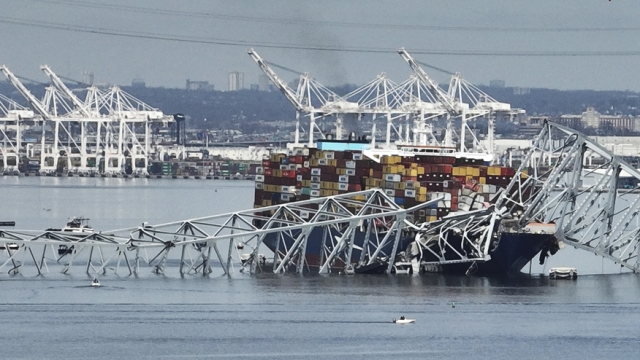BALTIMORE — A massive cargo ship plowed into Baltimore’s Francis Scott Key Bridge early Tuesday, causing the 1.6-mile bridge to crumble like a pile of toothpicks and plunge cars and people into the frigid water below.
Here’s what we know about the catastrophe:
Why did the bridge collapse?
Shortly before 1:30 a.m. Tuesday, a Singaporean-flagged container vessel called DALI struck one of the bridge’s pillars, officials said.
The ship is about 984 feet long, according to MarineTraffic data. That’s the length of three football fields.
Moments before the disaster, the DALI reportedly lost propulsion and dropped its anchor as part of its emergency protocol, the Maritime and Port Authority of Singapore said in a written statement.
“The ship management company, Synergy Marine Pte Ltd, reported to MPA that just prior to the incident, the vessel, Dali had experienced momentary loss of propulsion,” the statement said. “As a result, it was unable to maintain the desired heading and collided with the Francis Scott Key bridge.”
Video footage showed lights flickering aboard the ship shortly before the catastrophe.
“We can confirm that the crew notified authorities of a power issue” before the crash, Maryland Gov. Wes Moore said Tuesday. He said the ship had apparently lost power.
Footage of the crash also showed the vessel was in the wrong part of the channel as it approached the bridge.
The ship crashed into a pillar toward one side of the bridge instead of crossing under the middle of the bridge, where the clearance is highest.
“If you look at it, it’s off center of where it should be,” Maryland Transportation Secretary Paul J. Wiedefeld told CNN.
“Obviously, it should be in the main channel, which is under that main span.”
How many people are missing or injured?
At least six people who were on the bridge at the time of collapse are still missing, Wiedefeld told reporters about eight hours after the crash.
All six are construction workers who were filling potholes on the surface of the bridge when the ship crashed, Wiedefeld said. The construction work “had nothing to do with a structural issue at all,” Wiedefeld said.
Two people were rescued from the Patapsco River, Baltimore City Fire Chief James Wallace said. One of them was not injured, and the other was taken to a local trauma center in “very serious condition,” he said.
Sonar technology detected cars submerged in the water after the crash, but there are no known victims in those cars, Wiedefeld said. It’s possible the cars may have belonged to the construction workers.
No one aboard the DALI was injured, according to the ship’s management company, Synergy Group.
How dangerous is the water?
The Patapsco River is about 50 feet deep under the Francis Scott Key Bridge, Wiedefeld said.
It’s also frigid.
The water temperature in Baltimore Harbor near the site of the bridge collapse was about 46 to 48 degrees Fahrenheit on Tuesday morning. Any prolonged exposure to water under 55 degrees can be deadly, the National Weather Service said.
With water temperatures under 50 degrees, immediate incapacitation can occur and “sudden increases in heart rates and blood pressure” can cause a heart attack, the weather service said. Bodies lose heat four times faster in cold water than in cold air, which can quickly lead to hypothermia, confusion and shock.
“Unplanned immersion in cold water can be life-threatening for anyone without protection from the temperatures or a lifejacket to help you stay afloat,” the weather service said.
Swimmers without floatation can survive in water temperatures of 40 to 50 degrees for about 30 to 60 minutes, according to the University of Minnesota. With the aid of floatation devices, the likely survival time is about two to three hours.
Was this an accident or an intentional act?
There is no indication the ship’s crash and the bridge collapse were intentional, state and federal officials said.
Still, the FBI is on the scene. There are multiple reasons for that, former Deputy FBI Director Andrew McCabe said.
“The first is because when you have an event like this that calls for a massive response (and) resources, all of the local law enforcement entities, federal entities, whoever’s in the area, because of mutual aid agreements, will show up and contribute whatever resources they have,” McCabe told CNN.
For example, the FBI has “very experienced dive teams” that can help with the search, McCabe said.
Second, the FBI can help confirm whether the disaster was intentional. “They will look through all their intelligence holdings to see if there’s any chatter talking about plans or targeting, about locations like this, to see if there’s anything in the background that we should have been aware of and watching for,” McCabe said.
“Obviously, we’ve heard from numerous officials that that is not the case at this point.”
CNN’s Sahar Akbarzai, Andy Rose, Derek van Dam, Monica Garrett, AnneClaire Stapleton and Louis Mian contributed to this report.
Are you impacted by the Baltimore bridge collapse? Email the CBS 6 Newsroom



